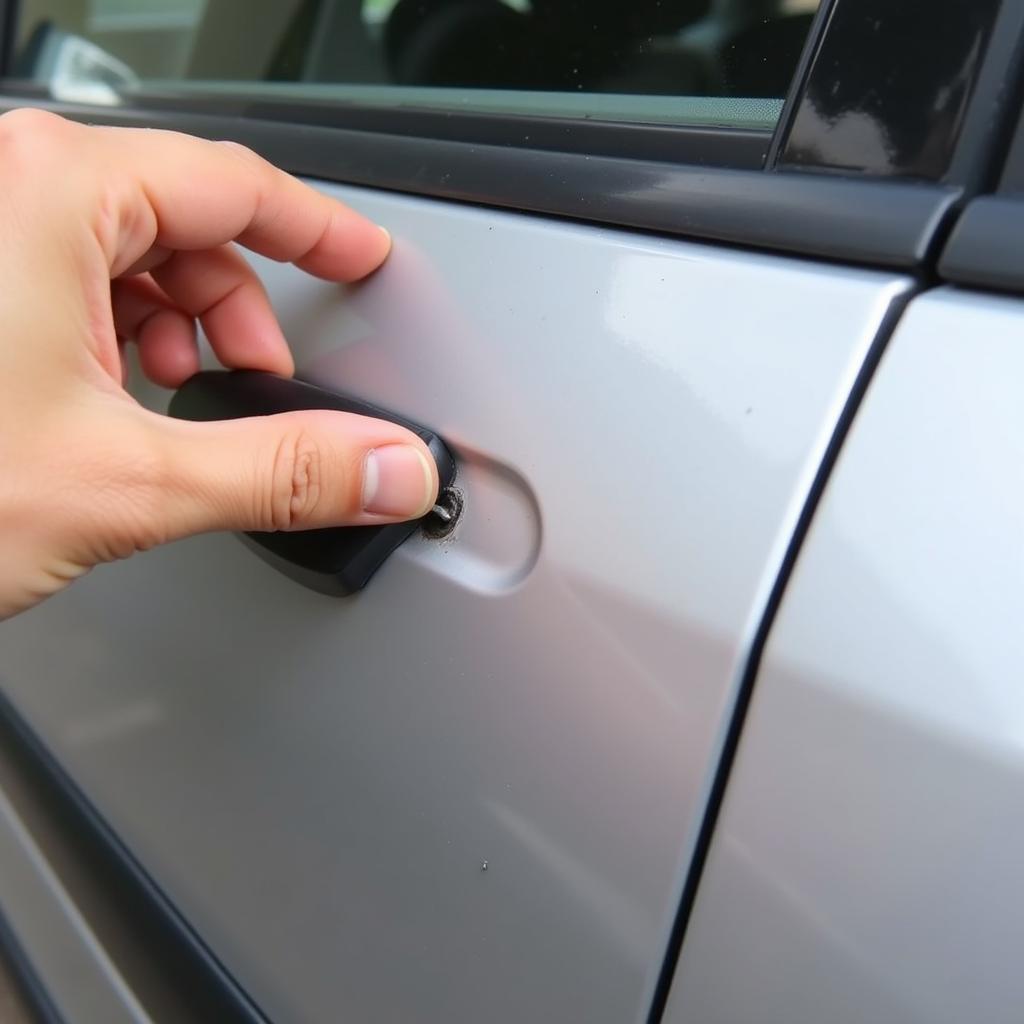Rust, that insidious enemy of any car owner, especially those with black vehicles where it stands out like a sore thumb, can be a real headache. Learning How To Fix Beginning Rust Spot On Black Car can save you a significant amount of money and preserve the beauty of your vehicle. This article will provide a comprehensive guide on tackling those early signs of rust, from identification to prevention.
Identifying the Early Stages of Rust on Your Black Car
Is it rust, or just a stubborn dirt spot? With black cars, this can sometimes be difficult to determine. Look for small, reddish-brown spots, especially around areas prone to chipping or scratches like wheel wells, door edges, and the hood. Surface rust appears as a discoloration and might feel slightly rough to the touch.
Gathering Your Rust-Fighting Arsenal
Before you start tackling those rust spots, gather the necessary tools and materials. This usually includes sandpaper (various grits), masking tape, primer, touch-up paint, clear coat, rubbing compound, and a microfiber cloth. A rust converter can also be beneficial, especially for stubborn spots.
How to Fix Beginning Rust Spot on Black Car: A Step-by-Step Guide
- Clean the Affected Area: Wash the area thoroughly with soap and water, then dry completely. This will remove any dirt or debris that could interfere with the rust removal process.
- Sanding Away the Rust: Use sandpaper, starting with a coarser grit (like 150) to remove the rust. Sand lightly, just enough to remove the rust, and gradually switch to finer grits (like 220 and then 320) to smooth the surface. Don’t overdo it, you don’t want to remove excessive clear coat or paint.
- Apply Rust Converter (Optional): If you’re using a rust converter, apply it to the affected area following the manufacturer’s instructions. This will convert any remaining rust into a stable compound.
- Masking and Priming: Mask off the surrounding area with masking tape. Apply a thin, even coat of automotive primer to the sanded area. This provides a protective layer and promotes better paint adhesion.
- Applying Touch-Up Paint: Apply thin coats of touch-up paint that matches your car’s color. Allow each coat to dry completely before applying the next. Several thin coats are better than one thick coat.
- Clear Coat Application: Once the paint is dry, apply a few coats of clear coat to protect the paint and match the surrounding finish.
- Buffing and Polishing: After the clear coat has dried, use a rubbing compound and a microfiber cloth to buff and polish the area, blending it seamlessly with the rest of the car’s finish.
Preventing Future Rust Spots
Preventing rust is always better than having to fix it. Regularly washing and waxing your car can help protect the paint and prevent rust formation. Keeping your car clean, especially during winter months when road salt can accelerate rust formation, is crucial.
“Rust is like a cavity in your car. The sooner you address it, the less damage it will cause.” – John Smith, Automotive Engineer at Autotippro
The Importance of Early Intervention
Addressing rust spots early on can prevent them from spreading and causing more significant damage, which can be costly to repair. Remember, a little preventative maintenance goes a long way.
“Regular waxing is like sunscreen for your car’s paint, protecting it from the harsh elements and preventing rust.” – Jane Doe, Lead Technician at Autotippro
How to Fix Beginning Rust Spot on Black Car: Conclusion
Fixing beginning rust spots on a black car is manageable with the right approach. By following the steps outlined in this guide, you can effectively address the issue and prevent further rust development. Remember that regular maintenance is key to keeping your car rust-free and looking its best. For expert assistance or personalized guidance, connect with us at AutoTipPro at +1 (641) 206-8880 or visit our office at 500 N St Mary’s St, San Antonio, TX 78205, United States.
FAQ
- Can I use any type of primer? It’s best to use an automotive primer designed for use on cars.
- What if the rust is deep? Deep rust might require professional repair or more extensive bodywork.
- How often should I wax my car? Waxing your car every three to six months is generally recommended.
- Can I prevent rust entirely? While you can significantly reduce the risk, completely preventing rust can be difficult, especially in harsh climates.
- How do I match the touch-up paint to my car’s color? Your car’s color code can usually be found on a sticker located inside the driver’s side doorjamb, under the hood, or in the glove compartment.
- What if I don’t have experience with car repair? If you’re unsure about any of the steps, it’s always best to consult a professional auto body shop.
- What’s the best way to remove rust from chrome? Chrome requires different methods and products than painted surfaces.





Leave a Reply